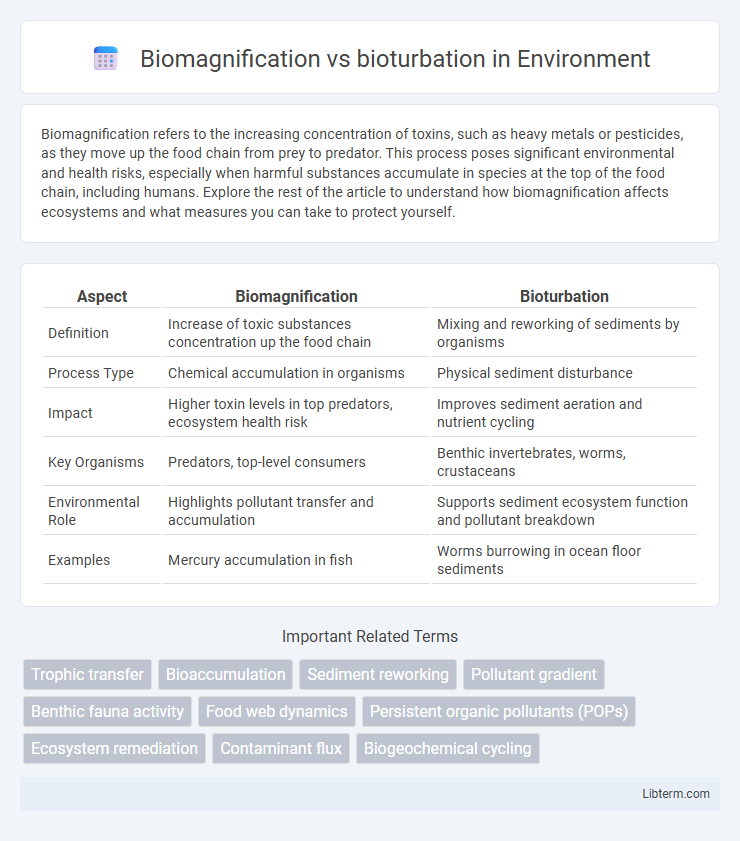Biomagnification refers to the increasing concentration of toxins, such as heavy metals or pesticides, as they move up the food chain from prey to predator. This process poses significant environmental and health risks, especially when harmful substances accumulate in species at the top of the food chain, including humans. Explore the rest of the article to understand how biomagnification affects ecosystems and what measures you can take to protect yourself.
Table of Comparison
| Aspect | Biomagnification | Bioturbation |
|---|---|---|
| Definition | Increase of toxic substances concentration up the food chain | Mixing and reworking of sediments by organisms |
| Process Type | Chemical accumulation in organisms | Physical sediment disturbance |
| Impact | Higher toxin levels in top predators, ecosystem health risk | Improves sediment aeration and nutrient cycling |
| Key Organisms | Predators, top-level consumers | Benthic invertebrates, worms, crustaceans |
| Environmental Role | Highlights pollutant transfer and accumulation | Supports sediment ecosystem function and pollutant breakdown |
| Examples | Mercury accumulation in fish | Worms burrowing in ocean floor sediments |
Introduction to Biomagnification and Bioturbation
Biomagnification refers to the increasing concentration of toxic substances, such as heavy metals or pesticides, in organisms at higher trophic levels of a food chain. Bioturbation involves the disturbance and reworking of sediment by benthic organisms, influencing sediment structure, nutrient cycling, and contaminant redistribution. Understanding the dynamics of biomagnification and bioturbation is essential for assessing ecosystem health and pollutant fate in aquatic and terrestrial environments.
Defining Biomagnification: Key Concepts
Biomagnification refers to the increasing concentration of toxic substances, such as heavy metals or persistent organic pollutants, in organisms at higher trophic levels of a food chain. This process occurs when contaminants accumulate in organisms and are passed onto predators, leading to amplified toxicity in apex species. Unlike bioturbation, which involves the disturbance and reworking of sediments by organisms, biomagnification specifically highlights the ecological risk posed by bioaccumulative toxins through trophic transfer.
Understanding Bioturbation Processes
Bioturbation refers to the reworking of soils and sediments by organisms such as worms, mollusks, and crustaceans, which alters sediment structure and enhances nutrient cycling. This process increases sediment oxygenation and influences the distribution and degradation of organic contaminants, contrasting with biomagnification, where pollutants accumulate through food webs. Understanding bioturbation dynamics is crucial for assessing sediment quality and ecosystem health in aquatic environments.
Causes and Mechanisms of Biomagnification
Biomagnification occurs when toxic substances like mercury and persistent organic pollutants accumulate in organisms at increasing concentrations up the food chain due to inefficient metabolic breakdown and elimination. This process is driven by bioaccumulation in individual organisms and trophic transfer during predation, resulting in higher contaminant loads in apex predators. In contrast, bioturbation involves the physical disturbance of sediments by benthic organisms, affecting sediment structure and nutrient cycling without concentrating toxins through trophic levels.
Ecological Role of Bioturbation
Bioturbation plays a crucial ecological role by enhancing sediment oxygenation and nutrient cycling, which supports diverse benthic communities and maintains ecosystem productivity. Through the physical disturbance of sediments by organisms like worms and crustaceans, bioturbation promotes the breakdown of organic matter and reduces the accumulation of harmful substances that can bioaccumulate and biomagnify through food webs. This process helps regulate contaminant levels, mitigating the negative effects of biomagnification on higher trophic organisms and overall ecosystem health.
Impact of Biomagnification on Food Chains
Biomagnification leads to the increasing concentration of toxic substances, such as heavy metals and persistent organic pollutants, as they move up through trophic levels in food chains. This process results in higher exposure and amplified harmful effects on apex predators, including reproductive failure and mortality. The disruption caused by biomagnification can destabilize ecosystems by reducing biodiversity and altering species interactions.
Bioturbation and Sediment Nutrient Cycling
Bioturbation significantly enhances sediment nutrient cycling by disturbing and aerating sediment layers, facilitating the breakdown of organic matter and the release of essential nutrients like nitrogen and phosphorus. This process supports microbial activity and improves sediment-water interface exchange, promoting ecosystem productivity in aquatic environments. Unlike biomagnification, which concentrates toxins through trophic levels, bioturbation directly influences sediment chemistry and nutrient dynamics critical for maintaining benthic habitat health.
Comparing Effects: Biomagnification vs Bioturbation
Biomagnification increases toxin concentrations as contaminants move up the food chain, posing severe risks to apex predators and ecosystem health. Bioturbation enhances sediment mixing by benthic organisms, influencing nutrient cycling and contaminant redistribution but not necessarily increasing toxin levels in higher trophic levels. Comparing effects reveals biomagnification amplifies pollutant toxicity through trophic transfer, whereas bioturbation primarily alters sediment structure and chemical bioavailability.
Environmental Implications and Case Studies
Biomagnification results in the increasing concentration of toxic substances like mercury and DDT in higher trophic levels, leading to severe ecological and health consequences as seen in the Minamata disease case in Japan. Bioturbation influences sediment chemistry and pollutant distribution by the reworking of sediments by organisms such as worms and crabs, affecting contaminant bioavailability and nutrient cycling in aquatic environments like Chesapeake Bay. Understanding the contrasting environmental implications of biomagnification's toxic buildup versus bioturbation's sediment mixing helps in managing pollution and preserving ecosystem health.
Strategies for Mitigating Negative Impacts
Biomagnification mitigation strategies emphasize reducing pollutant sources, particularly heavy metals and persistent organic pollutants, through stricter industrial regulations and improved wastewater treatment. Bioturbation management focuses on preserving benthic habitats and minimizing sediment disturbance to maintain natural detoxification processes and limit contaminant release. Integrating ecosystem-based management approaches enhances resilience against both biomagnification and bioturbation-related ecological disruptions.
Biomagnification Infographic

 libterm.com
libterm.com